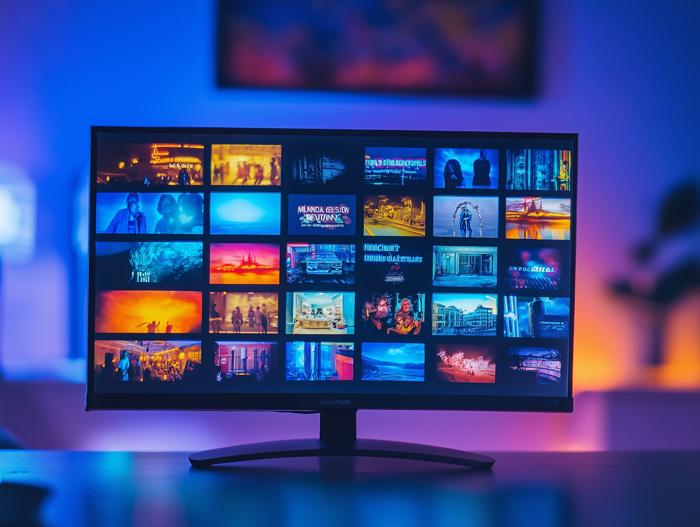The entertainment industry has undergone a massive transformation in the past decade, largely driven by the rise of streaming services. What began as a simple alternative to traditional cable TV has now evolved into the dominant force in the way we consume television, movies, and even music. From platforms like Netflix, Hulu, and Amazon Prime Video to newcomers like Disney+ and Apple TV+, streaming services have not only disrupted traditional media but have also reshaped the entire entertainment landscape. In this article, we will explore how streaming services are changing the entertainment industry, looking at the effects on content production, distribution, audience behavior, and the traditional television and film industries.
The Rise of Streaming: A Brief Overview
Streaming services first started to gain traction in the early 2000s. Netflix, initially a DVD rental service, made a pivotal shift in 2007 by launching its streaming service. The company was one of the first to offer on-demand access to movies and TV shows via the internet, eliminating the need for physical media or scheduled viewing times. This approach allowed viewers to watch content on their own terms, fostering a new era of entertainment consumption.
Over time, other services followed suit, with Hulu launching in 2008 and Amazon Prime Video entering the market shortly after. These platforms grew rapidly by offering vast libraries of on-demand content. Today, streaming services have become so ingrained in daily life that they have changed the way people watch content, how content is made, and even the way entertainment is marketed and consumed.
Changing Content Production
One of the most significant changes brought about by streaming platforms is the shift in how content is produced. Traditional TV networks and film studios are no longer the sole gatekeepers of major projects. With streaming services producing their own original content, the entertainment industry has seen a revolution in storytelling, formats, and creative freedom.
Original Content Production
Platforms like Netflix, Amazon Prime Video, and Hulu have increasingly invested in producing their own content, often referred to as “originals.” These productions are not just limited to series; they include feature films, documentaries, and stand-up specials. In some cases, streaming services have even overtaken traditional networks and film studios in terms of the size and scope of their original offerings.
One key advantage that streaming platforms have is the ability to cater to niche markets. While traditional networks might limit their programming to more mainstream tastes, streaming services can create shows and movies that might have struggled to find an audience through traditional distribution channels. This has led to a golden age of TV, with diverse and groundbreaking content becoming more prominent. Shows like Stranger Things, The Crown, and The Mandalorian showcase the immense creative possibilities afforded by streaming platforms.
Freedom and Flexibility in Storytelling
With their ability to reach global audiences, streaming platforms allow for more diverse and daring content. Writers, directors, and showrunners can tell stories without the same restrictions imposed by traditional TV networks. Content can explore more complex themes, push boundaries, and embrace innovative formats.
For instance, the shift from episodic to bingeable content has completely altered how stories are structured. Shows on Netflix often release all episodes of a season at once, encouraging viewers to watch them in a single sitting. This has led to the development of more intricate, character-driven narratives, as creators no longer need to worry about keeping viewers engaged week-to-week through cliffhangers. The binge-watching culture has also redefined the pacing of storytelling, with viewers experiencing a story in one long, continuous arc.
Changes in Content Distribution
The impact of streaming services on content distribution is profound. Gone are the days when viewers had to wait for weekly episodes on a specific channel or theater release dates to watch a movie. Now, entertainment is available on-demand, anytime and anywhere, often in multiple formats.
Global Reach and Access
Streaming services have given content a much broader reach. A show or movie that might have been limited to a specific country or region can now be available globally, often with the same release date across multiple countries. Services like Netflix offer content in a variety of languages and formats, creating a truly global entertainment experience. This is particularly beneficial for international audiences who now have access to a wider variety of content from different countries.
Furthermore, the rise of streaming has allowed for more inclusive programming. Platforms can make localized versions of content and even produce original shows in foreign languages, contributing to a richer, more varied catalog of programming. For instance, Money Heist, a Spanish-language series, became a global phenomenon, thanks to its accessibility on platforms like Netflix.

Subscription and Ad-Free Models
Streaming services have also changed the way entertainment is monetized. Instead of relying on traditional ad-supported television or box office revenue, services like Netflix, Amazon Prime, and Disney+ operate on subscription-based models. This has led to the growth of the “ad-free” entertainment experience, where subscribers can watch content without interruptions from commercial breaks. Additionally, these platforms often provide various subscription tiers, offering flexibility in pricing and content access.
While there are still some services, such as Hulu, that offer ad-supported tiers, many platforms have embraced the model of providing an uninterrupted viewing experience. This has been particularly appealing to viewers who seek more control over their entertainment experience.
Audience Behavior: A New Way to Consume Entertainment
The evolution of streaming services has fundamentally changed audience behavior, influencing how people watch and interact with content.
Binge-Watching Culture
Perhaps the most noticeable shift in audience behavior is the rise of binge-watching. With platforms releasing entire seasons of shows at once, viewers now have the freedom to watch as much (or as little) as they want in one sitting. This new behavior has led to significant changes in how content is consumed. For instance, audiences can experience the entire arc of a story without waiting for a new episode every week, and they can choose to pace themselves as they see fit.
This shift has not only affected TV shows but also movies. The emergence of streaming platforms as a viable alternative to traditional theater-going has changed how films are distributed and consumed. The Irishman (2019), for example, was released on Netflix in addition to a limited theatrical release, allowing people to watch it from the comfort of their homes. Similarly, the ongoing global pandemic accelerated the release of films directly to streaming platforms, changing the way we view blockbuster films.
On-Demand Content and Personalization
Streaming services have also empowered audiences by offering personalized recommendations. With the help of data analytics and algorithms, platforms suggest content based on viewing habits, ensuring that users are consistently presented with shows and movies they are likely to enjoy. This personalized experience makes the discovery of new content much easier and has shifted the entertainment experience from a passive to an active one.
Streaming services have allowed viewers to avoid traditional programming schedules. There’s no need to tune in at a specific time to catch a show—everything is available on-demand. This flexibility has also led to the rise of “second screening,” where viewers often watch shows while simultaneously engaging with social media, participating in discussions, or following live updates. This shift has created a more interactive and immersive experience for audiences.
Impact on Traditional TV and Film Industries
Streaming services have fundamentally disrupted traditional TV and film industries. Cable TV subscriptions have steadily declined as more viewers turn to on-demand platforms. In the film industry, theatrical releases are no longer the only way to launch a major film. Streaming platforms like Netflix and Amazon Prime have made it possible for films to reach wide audiences without a traditional theater release. This has led to a more democratized distribution model, where films are no longer reliant on expensive advertising or box office sales to find an audience.
The End of Cable TV?
As more consumers opt for streaming services, cable TV subscriptions have experienced a significant decline, a trend that’s expected to continue. Streaming platforms offer lower prices, greater flexibility, and a more personalized experience compared to traditional cable packages. In the U.S., the number of cord-cutters (those who cancel cable TV subscriptions in favor of streaming) continues to grow, reflecting a massive shift in consumer preferences. Streaming services have become the primary way people consume television and movies, with many viewers opting for multiple subscriptions over paying for a cable bundle.
The Future of Film Releases
The future of film releases is also shifting. While streaming services have made direct-to-platform film releases more common, the theatrical experience isn’t disappearing entirely. Major franchises, like those from Marvel, DC, and Star Wars, still thrive in theaters, and many moviegoers enjoy the event experience that comes with a big-screen release. However, the success of films like The Irishman and Roma (which premiered on Netflix) has shown that streaming can be a viable platform for prestige cinema. With the success of streaming platforms at awards shows like the Oscars, it’s clear that the lines between theatrical and streaming releases are increasingly blurred.
Conclusion: The Ongoing Transformation of the Entertainment Industry
The rise of streaming services has undoubtedly transformed the entertainment industry in ways that were unimaginable just a decade ago. With an unprecedented level of access, flexibility, and personalized content, streaming has empowered both creators and audiences, offering more diverse and inclusive entertainment experiences. The convenience and affordability of streaming services have reshaped how we consume TV shows, films, and even music, leading to a new golden age of television and cinema.
While traditional TV and film industries are adjusting to these changes, the future of entertainment is firmly rooted in the streaming model. As new platforms continue to emerge and established ones grow, the shift from scheduled programming to on-demand, personalized content will only intensify, ensuring that the entertainment industry continues to evolve in the years to come.
Streaming services have changed the way we watch, the way content is made, and the way the industry operates—and they’re far from finished.
How Streaming Services Are Changing the Entertainment Industry
412
previous post



